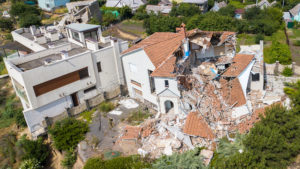Between 1851 and 2017, there were a total of 91 major hurricanes (categories 3-5). The two most expensive Hurricanes, Katrina and Harvey, each cost $125 billion in damages. This amount doesn’t take into account tornadoes, earthquakes and tsunamis that tear through homes across the world. How would your home hold up if devastation were to strike?
 Protect your home before a storm surges. Here are nine effective ways you can disaster-proof your home. With these tips, you can protect your property before it’s too late.
Protect your home before a storm surges. Here are nine effective ways you can disaster-proof your home. With these tips, you can protect your property before it’s too late.
1. Impact Windows
Imagine a strong gust of wind slamming into your windows, shattering the glass. Water rushes everywhere, ruining your furniture, flooring and valuables.
Hurricane-force winds can throw everything from bicycles to tree branches at your home. To protect yourself, you need to create the right disaster-proof home improvement. Impact windows can help you avoid these costly losses, especially if you live near the coast. Homes along the coast are vulnerable to a hurricane’s intense winds. Given this vulnerability, more people are investing in these windows to protect their homes. Impact-resistant windows and doors account for almost 10% of the market. In fact, both products are expected to continue experiencing constant growth into the new year. Before Hurricane Katrina, the Florida building code didn’t require impact windows. Now, insurance companies are creating stricter regulations to protect themselves from losses. Impact windows are designed to withstand the impact of a 2×4 stud at 150 miles per hour. They’re created with laminated glass and a sheet of Kevlar. While costly, imagine the money you can save by avoiding broken windows in an unforgiving hurricane.
2. Take a Look at Your Landscaping
The area around your home can cause problems, too. Make sure to remove any loose items outside your home that hurricane-force winds could lift off the ground. These can include:
- Dead branches
- Patio furniture
- Children’s toys
- Potted plants
- Door hanging wreaths
Before the storm hits, make sure to prune your trees. Take a look around. Is there anything else a hurricane could throw at your home? Pack it up and tuck it away!
3. Close the Front Door
Doors into your home, including your garage door, also pose a threat. Garage doors are an especially weak spot, especially when hurricane winds pick up. If those winds get a chance to enter your home, they could even tear the roof off! When these winds invite themselves into your home, they put pressure on the roof. To avoid this, and the expenses attached, make sure to have a hurricane-proof garage door installed. These doors can withstand intense storm surges. Some impact-rated garage doors can also brace against the existing door. That way, it won’t break while keeping your family and possessions safe.
4. Design with Uplift in Mind
We’ve described a few different ways a hurricane can rip your home apart. Whether the point of entry is your front door or the garage door, hurricane winds could destroy your home. Consider researching a code-mandated construction fastening system. Hurricane straps are galvanized steel pieces that secure your home’s walls to the rafters. These can be installed during a retrofit. While an expensive process, it can save your home from total damage. If your home has already been built, someone will need to cut back the sheetrock to expose the beams. If you’re about to build a new home, ask about installing the straps before the sheetrock is laid down. This home design option could help limit the damage. Lateral anchors, hold-downs and embedded connections can all fasten your home. However, the type of fastener depends on where you live and your home’s design.
5. Caulking Check
Examine the caulking around your home’s windows and doors. Check for any cracks, breaks, holes and gaps. Fill any of these gaps, especially ones around pipes or wires. Updating your caulking can help reduce the risks of leaks. Otherwise, rainwater can seep in through these gaps.
6. Know the Water Flow
Check all of your gutters and downspouts. If they’re clogged by plant life and debris, clean them out. Make sure nothing blocks water flow during the storm. During your check, make sure the downspouts are pointed away from your home. Otherwise, your root or attic might experience water damage.
7. Prepare Your Appliances
A single lightning strike or short circuit could cause your home’s power voltage to skyrocket. In a millisecond, that damage is done, ruining your expensive kitchen equipment.
Make sure to unplug some of these appliances, including:
- Ovens
- Dishwashers
- Toaster ovens
- Coffee/espresso machines
- Refrigerators
If you’re worried about spoiled food in the fridge, you can also use a surge protector to limit the risk. While you’re at it, make a list of the belongings throughout your home. If anything is damaged, you can use photos to file a claim with your insurance company.
8. Hurricane Shutters
As you make a list of home improvements you need to protect your home, consider hurricane shutters, too. Hurricane shutters can protect your windows from debris. With hurricane winds slamming anything and everything into your home, you need that extra protection. Remember, a broken window will allow chaotic winds into your home. Those winds will cause the air pressure to rise and possibly cause the roof to blow off. Some insurance companies in certain states offer discounted rates for homeowners with hurricane shutters. They come in many different materials, too, such as polycarbonate plastic or metal.
9. Piling Up
Concrete pilings can elevate your home above the storm surge. These pilings support the structure of your home and keep it from collapsing. That way, you can ensure that your home withstands the hurricane’s heavy winds. If you’re building a new home, consider having it build on concrete pilings.
Withstand the Storm: 9 Ways to Protect Your Home from Natural Disasters
Disaster-proof your home against the storm surge this hurricane season. Use these nine ways to protect your home from natural disasters before the storm hits.
Let’s get your hurricane season prep started. Contact Blackmon Mooring & BMS CAT for full-service restoration and construction today.
